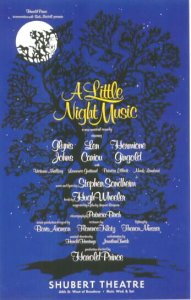
A Little Night Music is a musical with music and lyrics by Stephen Sondheim and book by Hugh Wheeler. Inspired by the 1955 Ingmar Bergman film Smiles of a Summer Night, it involves the romantic lives of several couples. Its title is a literal English translation of the German name for Mozart's Serenade No. 13, K. 525, Eine kleine Nachtmusik. The musical includes the popular song "Send In the Clowns", written for Glynis Johns.

Die Fledermaus is an operetta composed by Johann Strauss II to a German libretto by Karl Haffner and Richard Genée, which premiered in 1874.

Luigia "Gina" LollobrigidaOMRI was an Italian actress, model, photojournalist, artist and politician. She was one of the highest-profile European actresses of the 1950s and 1960s, a period in which she was an international sex symbol. She was among the last surviving high-profile international actors from the Golden Age of Hollywood cinema.
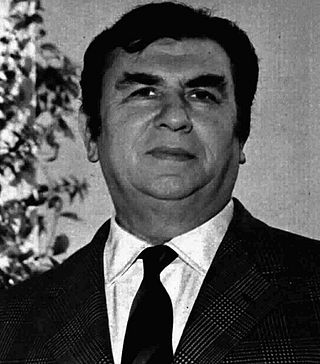
Luigi Cervi, better known as Gino Cervi, was an Italian actor. He was best known for portraying Peppone in a series of comedies based on the character Don Camillo (1952–1965), and police detective Jules Maigret on the television series Le inchieste del commissario Maigret (1964–1972).

Esmeralda, born Agnès, is a fictional character in Victor Hugo's 1831 novel The Hunchback of Notre-Dame. She is a French Roma girl. She constantly attracts men with her seductive dances, and is rarely seen without her clever goat Djali. She is around 16 years old and has a kind and generous heart.
A Mad World, My Masters is a Jacobean stage play written by Thomas Middleton, a comedy first performed around 1605 and first published in 1608. The title had been used by a pamphleteer, Nicholas Breton, in 1603, and was later the origin for the title of Stanley Kramer's 1963 film, It's a Mad, Mad, Mad, Mad World.

Mario Soldati was an Italian writer and film director. In 1954 he won the Strega Prize for Lettere da Capri. He directed several works adapted from novels, and worked with leading Italian actresses, such as Sophia Loren and Gina Lollobrigida.

Casanova 70 is a 1965 Italian comedy film produced by Carlo Ponti, directed by Mario Monicelli and starring Marcello Mastroianni, Virna Lisi, Enrico Maria Salerno and Michèle Mercier.

Il Boom is a 1963 commedia all'italiana film by Italian director Vittorio De Sica.
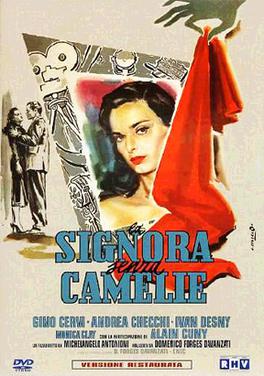
The Lady Without Camelias is a 1953 Italian black-and-white drama film directed by Michelangelo Antonioni and starring Lucia Bosé, Gino Cervi, and Andrea Checchi. Based on a story by Antonioni, the film is about a new starlet who is discovered and her experiences in Italian films. The film has been called "Antonioni's most unjustly neglected fiction feature." Filmed on location in Rome and Venice, The Lady Without Camelias was released on 27 February 1953 in Italy.
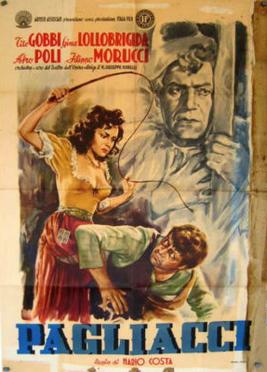
Love of a Clown, or Pagliacci, is a 1948 Italian film based on Ruggero Leoncavallo's opera Pagliacci, directed by Mario Costa. The film stars Tito Gobbi and Gina Lollobrigida. It recounts the tragedy of Canio, the lead clown in a commedia dell'arte troupe, his wife Nedda, and her lover, Silvio. When Nedda spurns the advances of Tonio, another player in the troupe, he tells Canio about Nedda's betrayal. In a jealous rage Canio murders both Nedda and Silvio. The only actor in the cast who also sang his role was the celebrated Italian baritone, Tito Gobbi, but the film is largely very faithful to its source material, presenting the opera nearly complete.

Cameriera bella presenza offresi... (Housemaid) is a 1951 Italian film directed by Giorgio Pastina. Federico Fellini was one of its scriptwriters. The film marked the comeback of Elsa Merlini after a nine years hiatus.

Les Belles de nuit is a 1952 French language motion picture fantasy directed and written by René Clair who co-produced with Angelo Rizzoli. The film stars Gérard Philipe, Martine Carol, Gina Lollobrigida and Magali Vendeuil. It was nominated the Venice Film Festival for Golden Lion.

The Cliff of Sin is a 1950 Italian melodrama film directed by Roberto Bianchi Montero and starring Gino Cervi, Margarete Genske and Delia Scala.
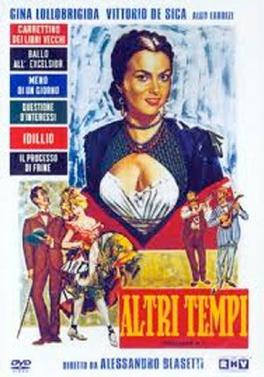
In Olden Days is a 1952 Italian comedy drama anthology film directed by Alessandro Blasetti and featuring an ensemble cast that included Gina Lollobrigida, Amedeo Nazzari, Vittorio De Sica, Elisa Cegani, Barbara Florian, Aldo Fabrizi, Andrea Checchi and Alba Arnova. It was shot at the Cinecittà Studios in Rome. The film's sets were designed by the art directors Dario Cecchi and Veniero Colasanti. It is also known as Times Gone By and Infidelity.

The Amorous Adventures of Moll Flanders is a 1965 British historical comedy film directed by Terence Young and starring Kim Novak, Richard Johnson, and Angela Lansbury. It is based on the 1722 novel Moll Flanders by Daniel Defoe.

Crossed Swords or The Teacher of Don Juan is a 1954 historical swashbuckling adventure film directed by Milton Krims and starring Errol Flynn, Gina Lollobrigida and Nadia Gray. It was co-production between Italy and the United States. It was shot at the Cinecittà Studios in Rome. The film's sets were designed by the art director Arrigo Equini.

Beautiful But Dangerous is a 1956 French-Italian comedy drama romance film directed by Robert Z. Leonard. The picture is a biopic about Italian opera soprano Lina Cavalieri. The film was a co-production between Italy and France. For this film Gina Lollobrigida was awarded a David di Donatello for Best Actress.

My Widow and I is a 1945 Italian comedy film directed by Carlo Ludovico Bragaglia and starring Vittorio De Sica, Isa Miranda and Gino Cervi.
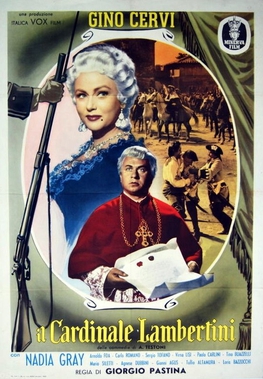
Cardinal Lambertini is a 1954 Italian historical comedy film directed by Giorgio Pastina and starring Gino Cervi, Nadia Gray and Arnoldo Foà. It is an adaptation of Alfredo Testoni's 1905 play Cardinal Lambertini, which had previously been turned into a 1934 film adaptation.



















